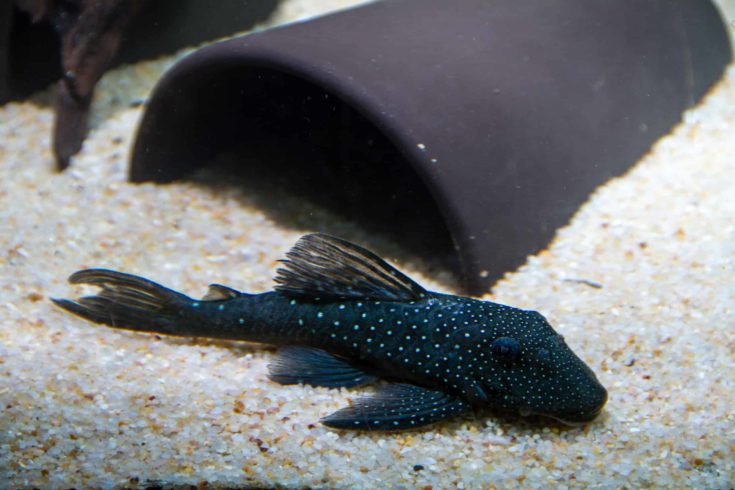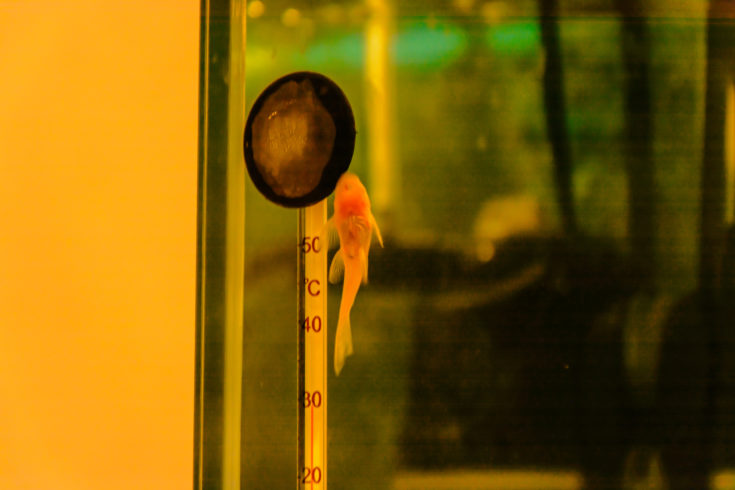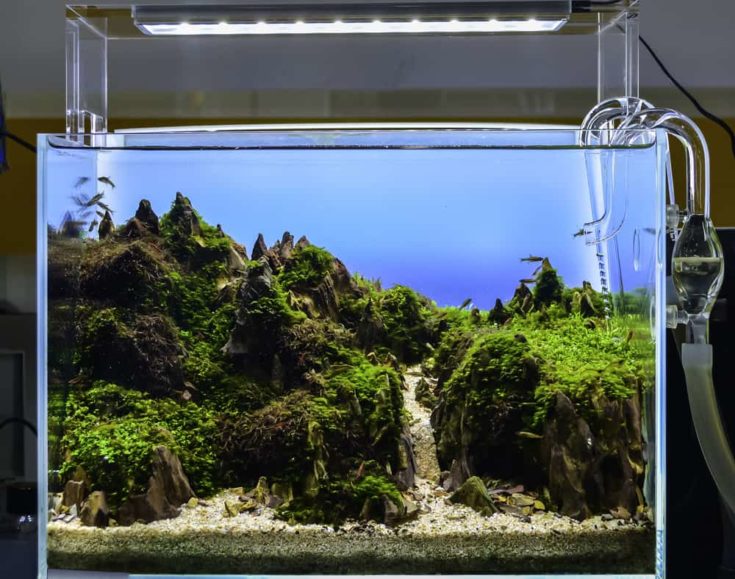When it comes to functional freshwater fish, one of the largest and most popular groups in the aquarium trade lations of Blue Phantoms are the algae-eating catfish known as Plecostomus. If you’re looking for a rare and unique bottom dweller for your mid-size community aquarium, then consider getting a beautiful Blue Phantom Pleco for your tank!
Quick Facts About Blue Phantom Plecostomus
Common Name (species)
Blue Phantom Plecostomus (Hemiancistrus species; L128)
Family
Loricariidae
Origin
Rio Orinoco, Venezuela
Care Level
Easy
Average Size
7-inches in length
Diet
Omnivore
Feeding
Offer daily meals of sinking algae wafers, spirulina pellets, and freshly blanched veggies, with a few weekly treats of brine shrimp, bloodworms, or other live treats
Activity
Nocturnal; more active at night and prefers to hide during the day
Temperament
Peaceful and mellow
Tank Level
Bottom dweller
Minimum Tank Size
50 gallons
Temperature Range
77 to 86°F
Water Hardness
2 to 12 KH
pH Range
6.0 to 7.0
Filtration/Flow Rate
Naturally lives in very clean, highly oxygenated water with a high/moderate flow rate, but tolerates mild currents as long as filtration and aeration are adequate
Breeding
Egglayer; male fish protect eggs until hatching. Rarely breeds naturally in captivity
Compatibility
Works well in most peaceful and semi-aggressive communities. Excellent option for Amazon-themed tanks with small cichlids, Characins and Silver Dollars
OK for Planted Tanks?
Yes, but may consume or uproot plants
Natural History of the Blue Phantom Plecostomus
Blue Phantom Plecos are members of the large armored suckermouth catfish family. They are a midsize, peaceful scavenger that does well in community aquariums from 50-gallon on up. Rarely bred in captivity, Blue Phantoms are scientifically classified as an unknown species in the Hemiancistrus genus.
To avoid confusion, aquarists use a system of L-numbers to identify unique varieties of Loricariidae catfish when the scientific names are absent or too broad (as with the Clown plecos and their mimics):

- Blue Phantoms are identified and sold as L128 under this system.
- They may be a southern variation or subspecies of the Green Phantom Pleco (Hemiancistrus subviridis), identified as L200.
- Blue Phantoms are a rarer but widely available variety of pleco that usually sells for a premium price, and it’s not uncommon to see them listed in the $50-150 range.
Habitat
While suckermouth catfish species are found throughout a broad range of Central and South America, populations of Blue Phantoms are only found in a limited and specific region. They are native to the Rio Orinoco in Venezuela, specifically the area downstream from Puerto Ayacucho:
- They live in the river rapids and hide under boulders and rocks during the day, and mostly feed on algae and plant materials along with small insects, worms and larvae.
- They’re tolerant of mild water flows as long as their water is clean and well-oxygenated.
Blue Phantom Appearance and Size
Phantoms have the typical Pleco body shape, with a wide suckermouth and flat head leading to a narrow body and upright dorsal fin. As diggers, they have strong, wide pectoral and abdominal fins as well. Blue Phantoms are a beautiful catfish with stunning markings:
- They have a charcoal black base color that can verge on a deep navy under certain lighting conditions.
- Their name comes from the small bluish-colored iridescent spots on their body and fins.
Blue Phantoms are usually sold as juveniles when they’re 3 to 5 inches in length, and they average about 7-inches from snout to tail at maturity. Like the other species of armored catfish, these plecos don’t have scales and are protected by heavy, thick plates instead.
Lifespan
Plecos typically live for about a decade in captivity, but it depends on their environment. If you keep your tank well-maintained and feed a balanced diet, you may have your Blue Phantom for 12 to 15 years!
Behavior and Temperament
Blue Phantoms are a mellow, shy and peaceful pleco that does very well in midsize to large community aquariums. While they usually hide under rocks and decor during the day, they can be quite active scavengers once the lights fade away. It’s fun to watch them swimming in your filter outflows or bubble walls with a moonlight!
As catfish, Blue Phantoms are opportunistic feeders and try to eat anything they come across. But unlike the giant and aggressive Common Pleco, they’re not active hunters and usually leave schooling fish alone. They’re not territorial, and you can keep them in groups or with other peaceful plecos like the Bristlenose.
How to Care for Your Blue Phantom Pleco
Blue Phantom’s are easy to care for overall, but they’re not as hardy as some plecos. It’s best to allow them plenty of time to acclimate to your local water conditions in a quarantine tank before introducing them to your aquatic community.
Tank Set-up and Habitat Requirements
While wild Phantoms usually live in waterways with heavy currents, waterfalls and rapids, captive fish tolerate aquariums with mild currents as long as their water is very clean and highly oxygenated.
Aquarium Size
Blue Phantoms are active bottom dwellers who need plenty of room to swim and scavenge in the lower parts of your tank. They’re ideal for tanks 50-gallons and up, especially long-style or breeder tanks. I recommend allowing an additional 25 to 50 gallons per Phantom to prevent stress.
Substrate
The ideal substrate for a Blue Phantom tank recreates their natural environment and includes a mix of soft sand and smooth pebbles. Avoid using harsh aquarium gravel, which could injure their abdomen or fins. Aquatic soils may also work, but these plecos usually make a muddy mess out of it.
Water and Temperature Parameters

Phantoms prefer warm, stable water temperatures between 77 and 86°F, so it’s best to use an aquarium heater. They prefer slightly soft water from 2 to 12 KH with a neutral pH from 6.0 to 7.0. Plecos get stressed when their conditions change suddenly and require extra time for acclimation.
Filtration and Aeration
While wild catfish prefer turbulent conditions, you don’t have to use a powerhead to make waves in your tank. As long as you have a good filtration system with replaceable filter media and maintain high water oxygenation with bubble devices or air stones, Blue Phantoms can tolerate living in tanks with mild currents.
I recommend using a robust canister or a couple of HOB filters, depending on your aquarium’s capacity and whether you’re using a powerhead as well. Dirty water and hypoxic or low-oxygen conditions cause these fish a great deal of stress and may significantly reduce their lifespans.
Lights, Plants and Decorations

As nocturnal fish plecos avoid bright areas of your tank during the day. They prefer to hide under piles of rocks or in crevices near your filter outflows. The ideal decor for a Phantom tank are tall piles of rocks and boulders. You can include some driftwood or branches as well, but these catfish don’t need a lot of wood. You can keep Phantoms in a planted aquarium, but they often uproot and damage live plants.
Maintenance
Blue Phantoms are not quite as hardy as other species of pleco and get very stressed when kept in dirty water. As voracious eaters, they produce a lot of waste, so plan on doing at least monthly water changes and filter maintenance on your pleco tank.
Feeding Blue Phantom Plecos
While these scavenging catfish enjoy eating aquarium algae and cleaning up the food scraps left by other fish, you’ll still need to offer your plecos commercial diets and treats to balance their nutrition. It’s best to feed Blue Phantom in the evening, when they’re just emerging from their hiding spots:
- Offer a daily meal of sinking algae wafers and spirulina pellets, with treats of freshly blanched veggies like cucumber, zucchini, and peas.
- Several times a week you can feed a protein-rich treat like live/frozen/dried brine shrimp, bloodworms, mosquito larvae or Daphnia eggs.
Tank Mates
These peaceful catfish do well in a variety of mixed communities, so the best tank mate really depends on your aquarium size and set-up. If you’d like to keep other turbulence-loving fish in a tank with a powerhead, consider doing an Amazon themed tank with Silver Dollar Fish and Flagtail Characins. You can keep Blue Phantoms with both peaceful and semi-aggressive communities:
- They’re a viable option for tanks of schooling tetras, hatchetfish, or barbs like the Tiger, Tinfoil and Odessa.
- They usually get along well with smaller cichlids, although they may eat any fry produced by a breeding group.
- Avoid keeping them with large, aggressive fish like Oscars or Common Plecos.
- They’re also an ideal option for aquariums with other friendly plecos like the Clown, Bristlenose, Candy Stripe, Sailfin, and Rubber Lip.
Breeding
There are a few reports of successful breeding in captivity, but most of these fish are captured in the wild and sold into the trade. It’s unlikely your plecos will breed in an aquarium or even a pond without the use of artificial hormones, even if you have a mixed-gender group.
Health Concerns
These plecos are usually healthy and don’t suffer from many common problems outside the usual water-borne parasites and infections. But Blue Phantoms are not as hardy as other types of plecos and are susceptible to stress when their conditions change. Always allow your fish extra time for acclimation, and don’t fall behind in your aquarium maintenance or water changes.
Blue Phantom Pleco Set-Up: Product and Equipment List
Let’s take a look at the list of supplies you’ll need to start a tank for your Blue Phantom Pleco! For a single Phantom community aquarium, you’ll need:
- 50-gallon or larger aquarium with a stand and cover/hood
- Filtration System (canister, HOB or combo)
- Airstone or bubbling device, air pump and plastic tubing
- Heater

- Sand and pebble substrate
- Variety of boulders, large and small rocks and driftwood decor
- Water conditioner
- Water testing kit
To feed your Blue Phantoms, you’ll need:
- Commercial sinking algae wafers and spirulina pellets
- Freshly blanched veggies
- Treats like live/frozen/dried brine shrimp, bloodworms, larvae or Daphnia eggs
Optional but often useful equipment for a pleco tank includes:
- Powerhead or aquatic wavemaker for turbulent aquarium
- LED aquarium lights and/or moonlight
- Live plants
Conclusion
What do you think about the Blue Phantom, and does it sound like a good algae eater for your aquarium? We’d love to hear your thoughts on these stunning spotted plecos, so share them below or splash-out with our larger community of fish keepers on our social media pages!
Nice job thank you